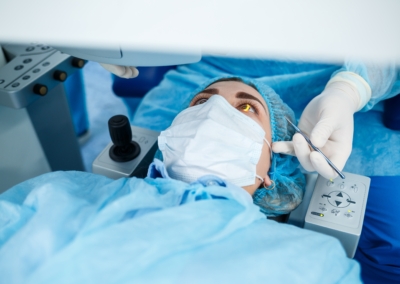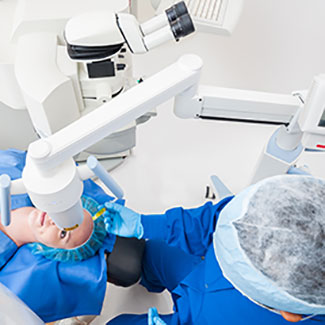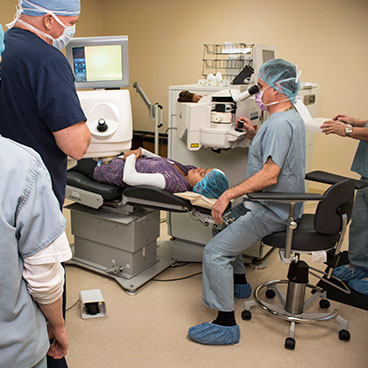What is Keratoconus?
Keratoconus, often referred to as ‘KCN’, is a non-inflammatory eye condition. Typically the cornea progressively thins and weakens causing the development of a cone-like bulge and optical irregularity. This causes distortion of your vision and can result in significant visual impairment.
Symptoms
Keratoconus typically first appears in individuals who are in their late teens or early twenties and may progress for 10-20 years. In the early stages of keratoconus, people might experience:
- Distortion of vision
- Increased sensitivity to light
- Can result in significant vision loss
- May lead to corneal transplant in severe cases
In the past, KCN was only corrected with surgery. Many patients needed to undergo a corneal transplant. Now newer and less invasive surgery is available. Epi-off crosslinking (CXL) is a Food and Drug Administration (FDA) approved treatment for progressive KCN. Epi-off refers to epithelial removal treatment. This is a less invasive treatment for KCN compared to a corneal transplant.
FDA clinical trials are currently being conducted for Epi-on crosslinking. Dr. Haverly is a principal investigator for the on-going Epi-on clinical trials. Contact Laser Eye Surgery of Erie if you have KCN and are interested in treatment and/or enrolling in the Epi on clinical trial.
You can find more information from the National Keratoconus Foundation at www.NKCF.org
>>>Watch Dr. Haverly’s feature on Erie News Now as he discusses Keratoconus treatment here<<<
What is Corneal Cross-Linking?
We are now offering procedures using the KXL® System, the first and only FDA-approved therapy for progressive keratoconus. The machine, created by Avedro, was approved in 2016, along with Avedro’s Photrexa® Viscous and Photrexa® solutions, and is being used in about 100 facilities nationwide. Cross-linking is a minimally invasive outpatient procedure that combines the use of UVA light and riboflavin eye drops to add stiffness to the corneas which have been weakened by disease.
Riboflavin
Riboflavin (vitamin B2) is important for body growth, red blood cell production and assists in releasing energy from carbohydrates. Under the conditions used for corneal collagen cross-linking, riboflavin 5’-phosphate, vitamin B2, functions as a photoenhancer which enables the cross-linking reaction to occur.
Ultra-Violet A (UVA)
UVA is one of the three types of invisible light rays given off by the sun (together with ultra-violet B and ultra-violet C) and is the weakest of the three. UVA light is applied to irradiate the cornea after it has been soaked in the photoenhancing riboflavin solution. This cross-linking process increases the number of molecular bonds, or cross-links, in the collagen.
Is cross-linking right for me?
Patients over the age of 14, who have been diagnosed with progressive keratoconus should ask their doctor about corneal cross-linking. Our practice is proud to offer patients the first and only FDA approved therapeutic treatment for progressive keratoconus.
For information on the FDA approved corneal cross-linking procedure for the treatment of keratoconus and corneal ectasia following refractive surgery, visit www.glaukos.com/int/cornea/cross-linking
Laser Eye Surgery of Erie
Additional Services
PTK and Amniotic Tissue Graft
Home Phototherapeutic Keratectomy (PTK) Phototherapeutic Keratectomy (PTK) and Amniotic Membranes with bandage contacts play an important role in treating…
read more
Corneal Transplants
Corneal transplants are required for a number of corneal diseases and a variety of other reasons. Before and after transplant,…
read more
Dry Eye
Dry eye occurs when people don’t produce enough tears or the right quality of tears to keep their eyes healthy…
read more
Diabetic Services
Diabetic retinopathy is a disease that affects diabetic people and eventually leads to blurry, distorted vision and blindness. When people…
read more
Macular Degeneration
Age-related macular degeneration (AMD) is a deterioration or breakdown of the eye’s macula. The macula is a small area in…
read more
Glaucoma Surgery and MIGS
iStent works like the stents used to prevent heart attacks and strokes. When blood vessels get clogged, a stent creates…
read more
Retinal Surgery
The retina is a thin sheet of nerve tissue in the back of the eye where light rays are focused…
read more
Keratoconus & Corneal Cross Linking
Keratoconus, often referred to as ‘KCN’, is a non-inflammatory eye condition in which the typically round dome-shaped cornea progressively thins…
read more
Glaucoma
Although glaucoma is the leading cause of blindness in Americans, early detection can prevent you from losing your eyesight. In…




